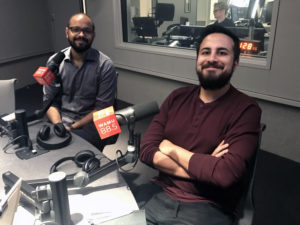Audiences in South America are hungry for good podcast content, much like their cousins to the north.

Sebastián Payán of 070 Podcasts from Colombia and Tiago Rogero of Negra Voz of Brazil are two of the 18 podcasters and journalists from across Latin America who spent several weeks in the U.S. last fall, describing their own podcasting experiences and meeting with producers from the Washington Post, NPR, Podcast Garage and others.
Brazil is the second-largest podcast production country in the world, second only to the U.S., Rogero says. “For journalism, it’s a good environment. The top 10 podcasts, both in Apple and Spotify, are news shows. For Spotify, it’s a podcast made from a Brazilian newspaper, for Apple it’s from Global TV. It’s an increasing environment. Things are getting better. There’s a lot of room to grow.”
But, admittedly, it’s a smaller audience for podcasts in Brazil than in the U.S., he says.
In Colombia, Payán says, there are new podcasts popping up every day, but there isn’t a lot of narrative work being done.
“It’s mostly talk shows you can hear on the radio,” he says. “You don’t see a lot of difference between radio and podcasts. Most of the podcasts come from outside media. You don’t see a lot coming from big media, they’re coming from independent media and producers. Even a lot of radio shows, they say they have podcasts, but they record the program and upload it without editing everything.”
Brazilian producers are trying to move forward and create different content that isn’t just something found on radio, but it’s a process.
“We have legacy media, legacy radio that are uploading shows as podcasts, but those same media do podcasts,” Rogero says. “They are live. They have sound design. We are kind of in the middle of this transition to figuring out that podcasts are a completely different media, but we already have a lot of good examples of podcasts in Brazil that are seeing these as a different media.”
Another difference they’re seeing on a larger scale: How podcasts are funded, and how that funding is discussed.
“In Colombia, you’d start doing the podcast and then think how are we going to finance,” Payán says. “Here, you see how the public media is investing in podcasting. We have seen here that podcasting has become another opportunity for journalists in times of crisis. There’s a big interest in storytelling podcasts. … You have to really try hard to do something new.”








Pingback: Los mejores podcasts según Edison Research - Vía Podcast